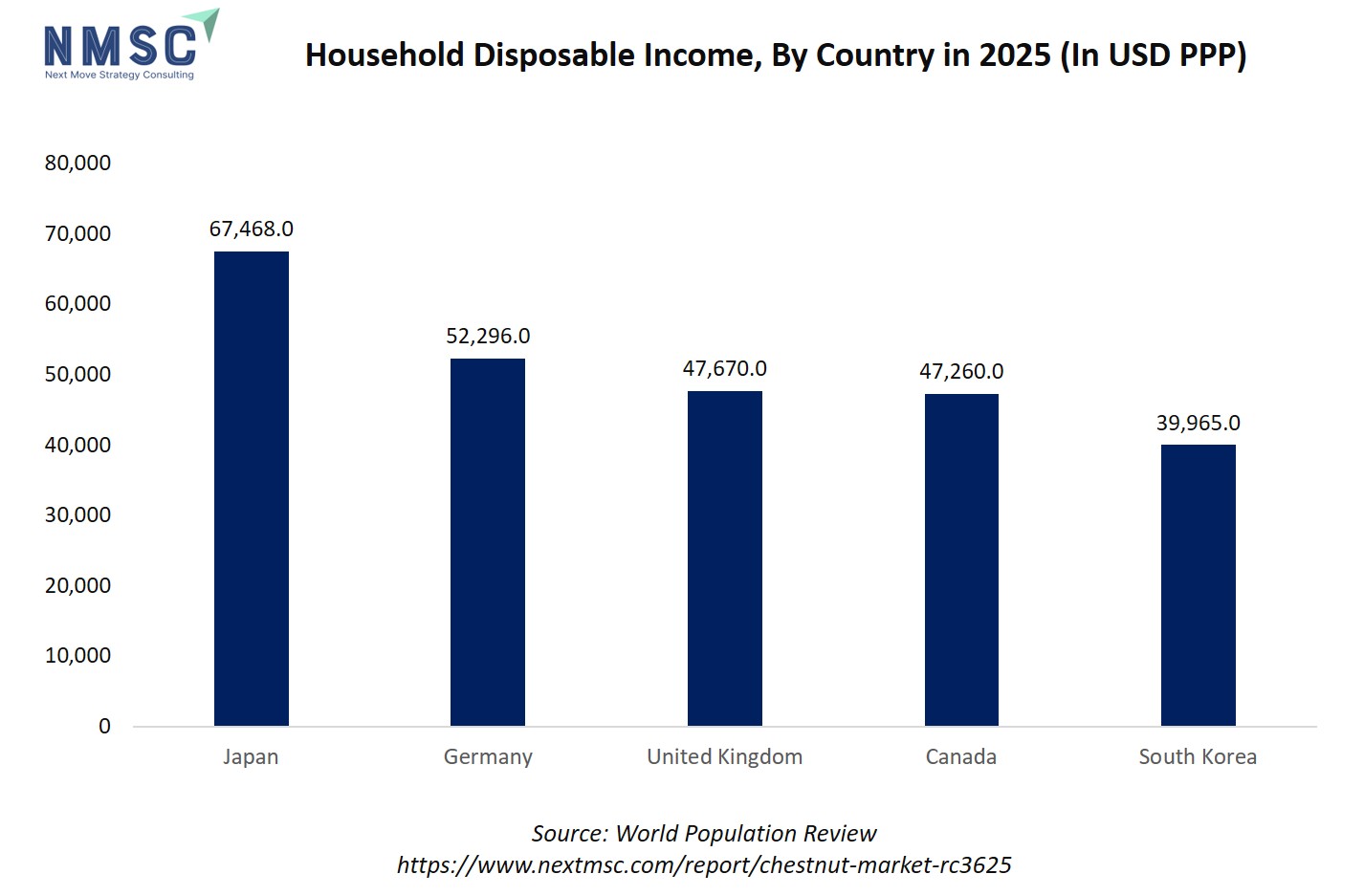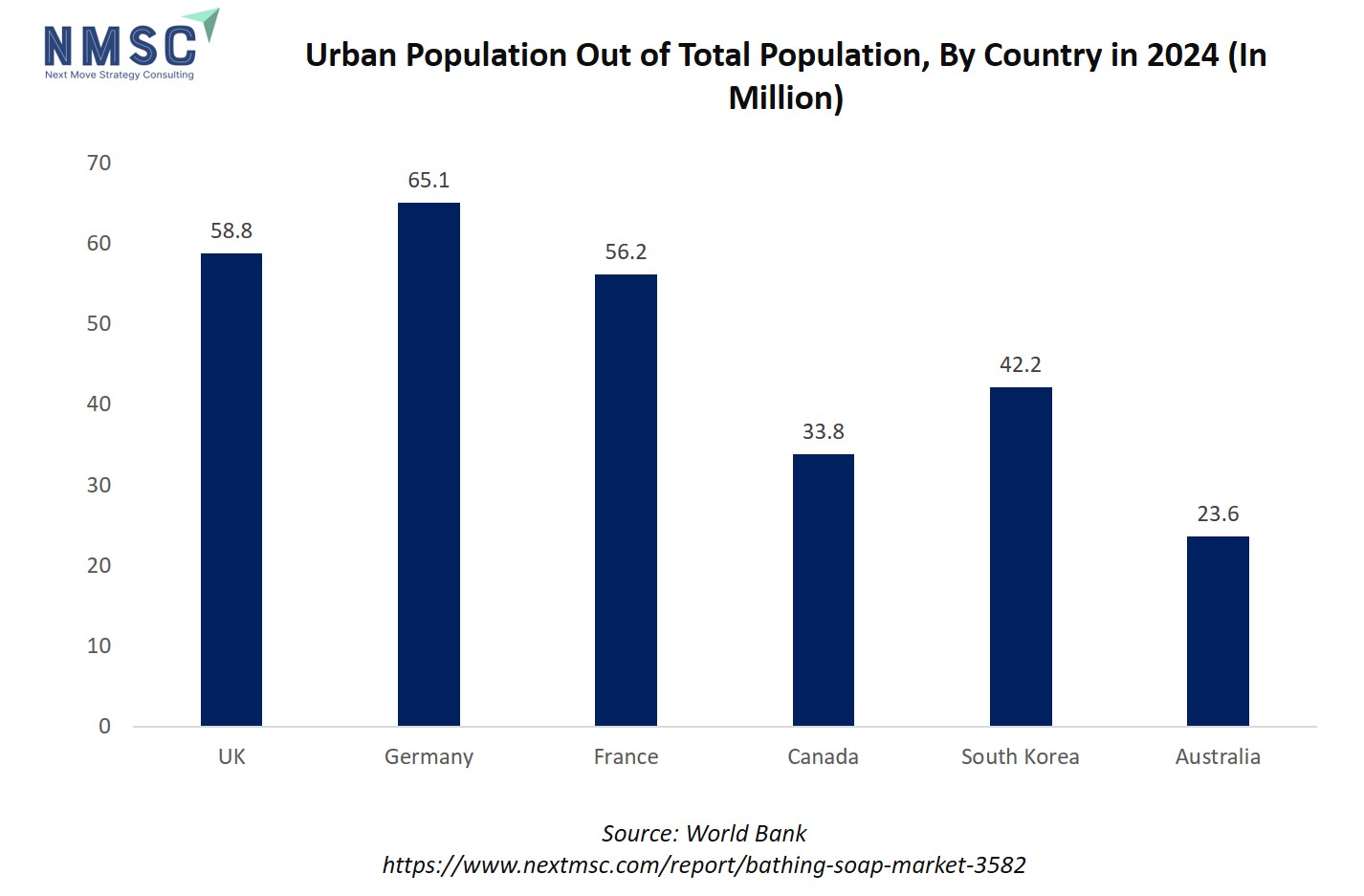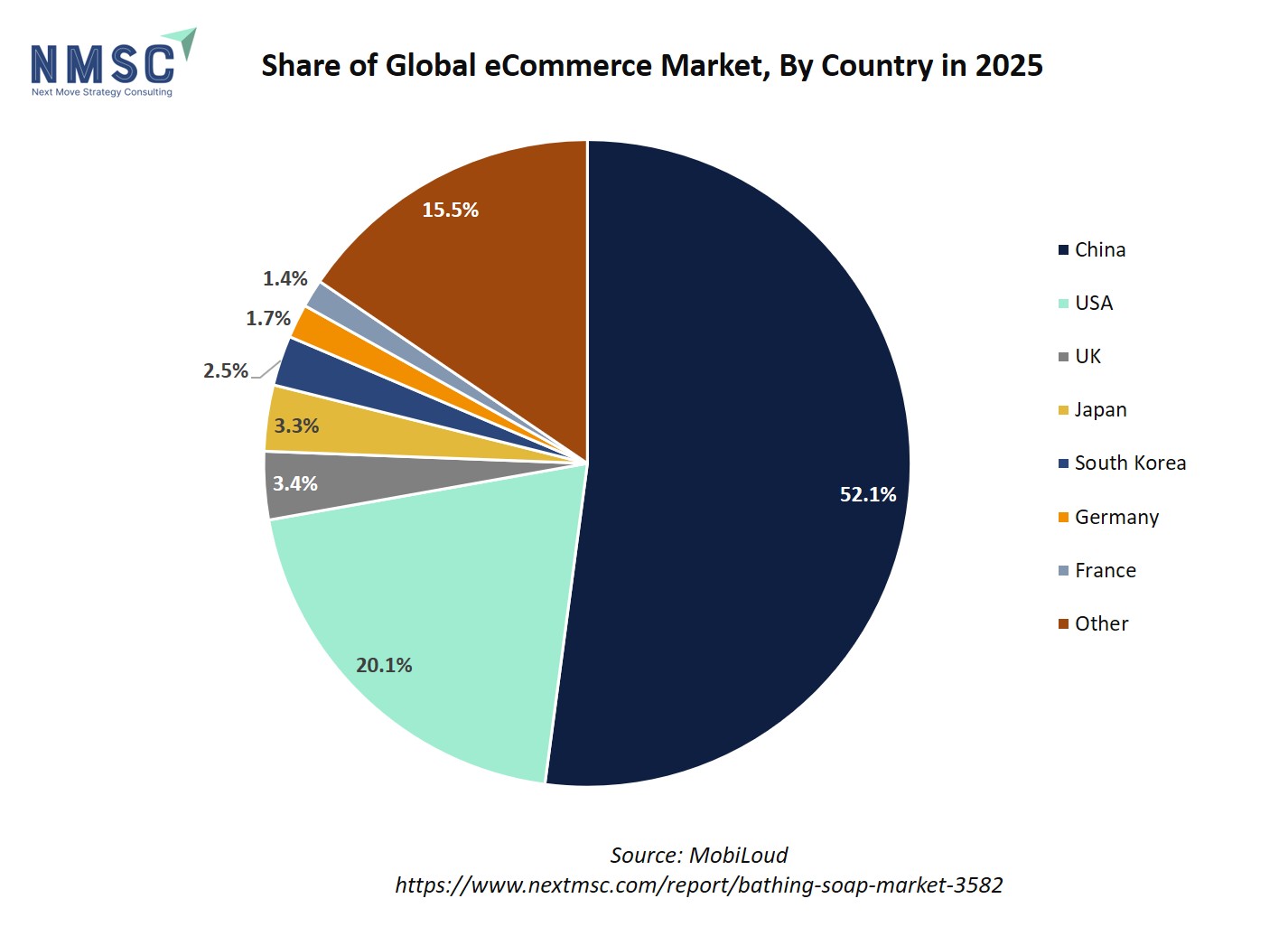
Chestnut Market by Species Type (Chinese Chestnut, American Chestnut, and Others), by Product Form (Fresh Chestnuts, Processed Chestnuts – Marrons Glacés, Chestnut Puree, Chestnut Flour, Chestnut Snacks, and Others), by Application (Food & Beverages – Snacks, Confectionery, Bakery Products, Beverages; Cosmetics & Personal Care; Pharmaceuticals) by Distribution Channel (Hypermarkets & Supermarkets, Specialty Stores, Online Retail, Direct-to-Consumer) – Global Analysis & Forecast, 2025–2030.
Industry Outlook
The global Chestnut Market size was valued at USD 4.64 billion in 2024, and is expected to be valued at USD 4.81 billion by the end of 2025. The industry is projected to grow, hitting USD 5.73 billion by 2030, with a CAGR of 3.56% between 2025 and 2030.
The market is witnessing significant transformation, driven by increasing health awareness, changing dietary preferences, and growing demand for nutrient-rich and plant-based food ingredients. Rising urbanization, disposable incomes, and consumer inclination toward natural and functional foods are fueling global market growth. Chestnuts are gaining traction as a versatile ingredient across bakery, confectionery, snacks, and dairy alternatives due to their gluten-free, low-fat, and high-fiber properties. Expansion of modern retail networks, online grocery platforms, and sustainable sourcing practices further enhance market penetration. Additionally, advancements in processing technologies, packaging innovations, and value-added chestnut products, such as flours, purees, and ready-to-eat snacks, are reshaping consumer choices, improving product shelf life, and strengthening brand positioning globally.
What are the key trends in market?
What are the major technological trends shaping the Market?
Technological advancements are significantly reshaping the market. Innovations in roasting, drying, and peeling technologies are enhancing product efficiency, flavor retention, and shelf life. Cold-pressing and vacuum processing techniques are improving the nutritional quality and freshness of chestnut-based products. Automation and AI-driven quality control systems are streamlining production, reducing waste, and ensuring consistent output. Furthermore, advancements in packaging technologies, such as biodegradable materials and modified-atmosphere packaging, are extending product life while minimizing environmental impact. Digital tools for supply chain traceability and smart logistics are also contributing to improved transparency and sustainability across the value chain.
How is demographic change influencing the market?
Demographic and societal changes are playing a vital role in the expansion of the market. Rising urbanization and disposable incomes, especially in Asia-Pacific and Europe, are fuelling the consumption of healthy and natural food products. Younger, health-conscious consumers are driving demand for plant-based and allergen-free snacks, while older demographics are increasingly attracted to the nutritional and digestive benefits of chestnuts. Additionally, the growing number of working professionals and dual-income households is boosting the popularity of convenient, ready-to-eat, and packaged chestnut products. These shifts are encouraging manufacturers to diversify product portfolios and cater to region-specific dietary preferences.
What role does government support play in driving industry growth?
Government initiatives are playing a pivotal role in fostering growth in the market. Supportive agricultural policies, reforestation programs, and subsidies for nut cultivation are strengthening the chestnut supply chain. Governments in countries like China, Italy, and South Korea are investing in rural development and processing infrastructure to promote chestnut farming and exports. Quality certification programs, food safety regulations, and research funding for sustainable production are further enhancing consumer trust and market competitiveness. Additionally, international trade agreements and incentives for small and medium enterprises (SMEs) are encouraging innovation, value addition, and global market expansion.
How is consumer preference changing in the market?
Consumer preferences in the chestnut market are evolving toward natural, organic, and sustainably sourced products. Modern consumers increasingly value transparency, nutrition, and environmental responsibility in food choices. There is growing interest in clean-label and additive-free chestnut products, as well as innovative offerings such as chestnut-based milk, spreads, and energy bars. Convenience-oriented formats like roasted or vacuum-packed chestnuts are gaining traction among busy urban consumers. Furthermore, the emphasis on eco-friendly packaging and ethical sourcing practices is driving brand differentiation. Overall, consumers are transitioning from traditional consumption patterns to premium, health-oriented, and environmentally conscious options.
What are the key market drivers, breakthroughs, and investment opportunities that will shape the chestnut industry in next decade?
The market is experiencing robust growth, driven by rising health consciousness, urbanization, and increasing disposable incomes, which are boosting demand for convenient, nutritious, and value-added products such as flours, purees, snacks, and gluten-free alternatives. Expansion of e-commerce platforms and modern retail channels is enhancing product accessibility, while digital marketing and targeted promotions are encouraging consumer adoption of premium offerings. Urban populations in major markets, coupled with higher household incomes, are creating strong demand for innovative and ready-to-eat chestnut products. Despite challenges from seasonal supply fluctuations and logistical constraints, opportunities in plant-based, gluten-free, and processed chestnut products are fueling market innovation and global expansion.
Rising household disposable incomes, measured in USD PPP, are a key driver for the chestnut market, as higher purchasing power allows consumers to spend more on premium, nutritious, and value-added food products. In 2024–2025, Japan leads with a per capita disposable income of USD 67,468 PPP, followed by Germany at USD 52,296 PPP, the UK at USD 47,670 PPP, Canada at USD 47,260 PPP, and South Korea at USD 39,965 PPP. These high-income levels indicate strong potential for consumption of chestnut-based products, including flours, purees, snacks, and gluten-free alternatives. Consumers in such markets are more likely to prefer convenient, healthy, and innovative chestnut offerings, driving market growth and encouraging manufacturers to develop diverse and premium product lines.
Growth Drivers:
How is Urbanization & Rising Disposable Incomes Driving the Chestnut Market Demand?
The rising urban population is a key factor driving growth in the market. According to the World Bank, urban population accounts for 66% of China’s total population and 84% of the U.S. population, reflecting significant urbanization in major markets. Urban lifestyles lead to higher demand for convenient, ready-to-eat, and processed food products, including chestnuts. Coupled with increasing disposable incomes, consumers in these regions are more likely to purchase premium and value-added chestnut products such as flours, purees, snacks, and gluten-free alternatives. This combination of urban concentration and purchasing power is boosting market demand and encouraging innovation in chestnut-based offerings.
The level of urbanization across countries plays a crucial role in shaping the chestnut market, as urban consumers tend to demand convenient, processed, and premium food products. In 2024, Germany leads with an urban population of 65.05 million, followed by the UK at 58.76 million and France at 56.21 million, highlighting a strong urban consumer base likely to drive demand for chestnut-based snacks, flours, and ready-to-eat products. South Korea (42.17 million) and Canada (33.84 million) show moderate urbanization, indicating growing potential for chestnut product penetration in these markets. Australia, with the lowest urban population of 23.60 million, represents a smaller but niche market where premium and health-focused chestnut products could gain traction. Overall, higher urban populations correlate with increased demand for convenient, value-added, and health-oriented chestnut offerings, supporting market expansion.
Is Expansion of E-Commerce and Modern Retail Channels Accelerating the Chestnut Market Growth?
The rapid growth of e-commerce platforms and modern retail networks is significantly accelerating the Market. Online grocery stores, specialty food websites, and subscription-based delivery services are making chestnut products more accessible to a wider audience, including urban and remote consumers. Supermarkets, hypermarkets, and convenience stores are increasingly stocking processed and value-added chestnut products such as flours, purees, roasted nuts, and ready-to-eat snacks, enhancing visibility and availability. This widespread distribution, combined with targeted digital marketing and promotional strategies, is driving higher adoption rates and encouraging consumers to try premium and innovative chestnut offerings. Overall, the expansion of retail and online channels is a major catalyst for market growth.
The pie chart depicts the global e-commerce market share by country in 2025. China dominates the market with a 52.1% share, accounting for over half of global e-commerce activity. The USA follows with 20.1%, while the UK and Japan contribute 3.4% and 3.3%, respectively. South Korea, Germany, and France hold smaller shares of 2.5%, 1.7%, and 1.4%, respectively. The remaining countries collectively represent 15.5% under the “Other” category.
Growth Inhibitors:
How Does Supply Chain and Seasonal Limitations Restraints the Chestnut Market Expansion?
One major restraint in the market is supply chain and seasonal limitations. Chestnuts are highly perishable and sensitive to climate conditions, which lead to fluctuations in availability and quality. Additionally, dependence on specific geographic regions for cultivation makes the market vulnerable to adverse weather, diseases, and logistical challenges. These factors increase production costs, limit consistent supply, and affect the pricing and profitability of chestnut-based products, particularly in processed and packaged formats.
How is Growing Demand for Plant-Based and Gluten-Free Products Creating Opportunity for the Market?
A significant opportunity in the market lies in the growing demand for plant-based and gluten-free products. With rising health awareness, veganism, and gluten intolerance concerns, chestnuts are being increasingly used as flours, snacks, purees, and dairy alternatives. Innovating with value-added products such as chestnut-based bakery items, energy bars, and ready-to-eat snacks cater to health-conscious and urban consumers. Expansion in e-commerce and modern retail channels further enhances the market potential, allowing brands to reach wider audiences globally.
How chestnut market is segmented in this report, and what are the key insights from the segmentation analysis?
By Species Type Insights
Which Species Type Is Expected to Drive the Chestnut Market in 2025?
On the basis of species type, the market is segmented into Chinese Chestnut, American Chestnut, European Chestnut, and Japanese Chestnut. The market in 2025 is expected to be primarily driven by Chinese Chestnut. Chinese chestnuts dominate global production due to their high yield, adaptability to various climates, and sweet, versatile flavor, making them highly preferred for snacks, roasted products, flours, and processed chestnut offerings.
While other species such as American, European, and Japanese chestnuts are gaining traction in niche applications—such as traditional European recipes, artisanal products, and specialty culinary uses—the Chinese Chestnut segment remains the backbone of the market. Additionally, Japanese and European chestnuts are emerging as high-potential categories, driven by increasing consumer interest in premium, organic, and specialty chestnut products catering to regional tastes and health-conscious preferences.
By Product Form Insights
Which Product Form Is Expected to Lead the Chestnut Market in 2025?
On the basis of product form, the market is segmented into Fresh Chestnuts and Processed Chestnuts. The market in 2025 is expected to be primarily driven by Processed Chestnuts. Processed products—including marrons glacés, chestnut puree, chestnut flour, snacks, and beverages—are gaining strong consumer preference due to convenience, longer shelf life, and versatility in culinary and bakery applications.
While fresh chestnuts remain popular for roasting, boiling, and direct consumption, the processed segment is emerging as a high-potential category, driven by demand for value-added, premium, and health-focused chestnut products. Innovations in packaging, ready-to-use formats, and gluten-free or plant-based applications are further boosting the market share of processed chestnuts globally.
By Distribution Channel Insights
Which Distribution Channel Is Expected to Drive the Chestnut Market in 2025?
On the basis of distribution channel, the market is segmented into Hypermarkets & Supermarkets, Specialty Stores, Online Retail, and Direct-to-Consumer (D2C). The market in 2025 is expected to be primarily driven by Hypermarkets & Supermarkets. These channels offer wide product visibility, accessibility, and convenience for consumers, making them the preferred choice for purchasing both fresh and processed chestnut products.
While specialty stores, online retail, and D2C channels are gaining traction—especially for premium, organic, or niche chestnut offerings—hypermarkets and supermarkets remain the backbone of market sales. The growth of modern retail infrastructure, coupled with increasing urbanization and rising disposable incomes, is further strengthening the dominance of these traditional retail channels in the global chestnut market.
By Application Insights
Which Application Segment Is Expected to Lead the Chestnut Market in 2025?
On the basis of application, the market is segmented into Food & Beverages, Cosmetics & Personal Care, and Pharmaceuticals. the market in 2025 is expected to be primarily driven by the Food & Beverages segment. Chestnuts are widely used in snacks, confectionery, bakery products, and beverages due to their nutritional value, versatility, and growing consumer preference for healthy, plant-based, and gluten-free foods.
While the Cosmetics & Personal Care and Pharmaceuticals segments are gaining momentum leveraging chestnut extracts for skincare, wellness, and therapeutic applications—Food & Beverages remains the backbone of the market. Rising demand for processed chestnut products, value-added innovations, and convenient consumption formats further strengthen the market share of this segment globally.
Regional Outlook
The market is geographically studied across North America, Europe, Asia Pacific, and the Middle East & Africa, and each region is further studied across countries.
Chestnut Market in North America
The North American market is being driven by rising health awareness, increasing disposable incomes, and growing consumer preference for natural, nutritious, and premium food products. Expanding retail networks, including supermarkets, hypermarkets, and e-commerce platforms, are enhancing product accessibility and visibility. Urban consumers are seeking convenient, ready-to-eat, and value-added chestnut products such as flours, purees, and snacks. The trend toward plant-based, gluten-free, and functional foods is creating additional growth opportunities for manufacturers across the region.
Chestnut Market in the United States
In the U.S., market growth is primarily fueled by increasing demand for health-oriented, plant-based, and premium chestnut products. Consumers are seeking nutrient-rich, gluten-free, and convenient options for baking, snacking, and meal preparation. Expansion of organized retail and online channels allows brands to reach diverse consumer segments, while innovative packaging and value-added product offerings are enabling differentiation and brand loyalty.
Chestnut Market in Canada
In Canada, the market is supported by rising urbanization, higher disposable incomes, and increasing health consciousness. Consumers prefer chestnut-based products that are nutritious, convenient, and versatile, such as flours, roasted nuts, and ready-to-eat snacks. E-commerce and modern retail channels are enhancing product reach, while sustainability and ethical sourcing trends are encouraging manufacturers to innovate in product offerings and packaging.
Chestnut Market in Europe
The European market is driven by growing focus on health, wellness, and eco-conscious consumption. Consumers are increasingly adopting premium, natural, and multifunctional chestnut products, including flours, purees, and snacks with nutritional benefits. Retail modernization, online shopping growth, and sustainability initiatives are improving product visibility and accessibility. Innovation in organic, gluten-free, and ready-to-eat offerings is creating opportunities for brands to cater to diverse consumer preferences across countries.
Chestnut Market in the United Kingdom
In the U.K., market growth is fueled by rising consumer awareness of nutrition, wellness, and premium plant-based foods. Urban populations with higher disposable incomes are driving demand for convenient and value-added chestnut products such as flours, snacks, and purees. The expansion of modern retail chains and e-commerce platforms is enhancing product availability and visibility. Additionally, interest in sustainable sourcing and eco-friendly packaging supports continued market adoption.
Chestnut Market in Germany
Germany’s market is primarily driven by consumer preference for nutritious, natural, and premium chestnut products. Urban populations with high disposable incomes are increasingly adopting roasted nuts, flours, and ready-to-eat snacks. Expansion of modern retail outlets and online channels enhances accessibility, while sustainability and ethical sourcing trends encourage the consumption of eco-friendly and high-quality chestnut products, supporting steady market growth.
Chestnut Market in France
In France, market growth is fueled by rising urbanization and health-conscious consumer behavior. There is increasing demand for natural, gluten-free, and multifunctional chestnut products with nutritional and functional benefits. Modern retail channels, including supermarkets, specialty stores, and e-commerce platforms, are improving product visibility and availability. Growing awareness of healthy lifestyles and eco-friendly practices further supports the adoption of premium chestnut offerings.
Chestnut Market in Spain
Spain’s market is driven by urbanization and rising disposable incomes, which are expanding access to modern retail and online platforms. Urban consumers increasingly prefer premium, natural, and multifunctional chestnut products, creating opportunities for innovation in processing, packaging, and flavor profiles. Sustainability trends and eco-conscious purchasing behavior further encourage the adoption of organic and chemical-free chestnut-based offerings, supporting steady market growth.
Chestnut Market in Italy
Italy’s market is fueled by rising health and wellness awareness and strong demand for premium, natural products. Consumers are seeking nutrient-rich, multifunctional chestnut products, supported by urbanization and higher disposable incomes. Expansion of modern retail outlets and e-commerce channels improves accessibility, while growing interest in sustainable and eco-friendly products drives differentiation and brand loyalty.
Chestnut Market in the Nordics
The Nordic market is primarily driven by high consumer awareness of health, wellness, and sustainable nutrition. Urban populations with higher disposable incomes are favoring premium, organic, and multifunctional chestnut products. Modern retail chains and online platforms enhance availability, while eco-friendly and ethically sourced offerings are increasingly preferred, supporting steady market growth.
Chestnut Market in Asia Pacific
The Asia Pacific market is experiencing rapid growth due to urbanization, rising disposable incomes, and increasing health consciousness. Countries such as India, China, South Korea, and Australia are witnessing strong demand for premium, natural, and multifunctional chestnut products. Expansion of modern retail and e-commerce channels is enhancing accessibility, while sustainability trends and eco-friendly practices are driving product innovation and adoption.
Chestnut Market in China
China’s market is fueled by urbanization, rising disposable incomes, and growing demand for premium and health-oriented products. Consumers increasingly prefer multifunctional, nutritious, and natural chestnut offerings. The expansion of e-commerce platforms and modern retail channels enhances product reach, while sustainability trends support eco-friendly and innovative product development.
Chestnut Market in Japan
Japan’s market is influenced by aging populations, high health awareness, and premiumization trends. Consumers increasingly demand gentle, nutritious, and multifunctional chestnut products suitable for wellness-oriented lifestyles. Accessibility through supermarkets, specialty stores, and e-commerce platforms, combined with a focus on sustainability and natural ingredients, is fostering market innovation and differentiation.
Chestnut Market in India
India’s market is being driven by rapid urbanization, rising disposable incomes, and increasing health consciousness. With an urban population of approximately 534.91 million, demand for premium, nutritious, and multifunctional chestnut products is rising. Expansion of modern retail outlets and e-commerce platforms, alongside growing focus on eco-friendly and chemical-free formulations, is creating strong opportunities for market growth and product innovation.
Chestnut Market in South Korea
In South Korea, urbanization, rising disposable incomes, and increasing health awareness are driving the Market. Consumers prefer premium, natural, and multifunctional chestnut products, supported by the widespread presence of modern retail chains and e-commerce platforms. Growing demand for eco-friendly and sustainable offerings is encouraging innovation in product formulations and packaging, sustaining consistent market growth.
Chestnut Market in Taiwan
Taiwan’s market is driven by health-conscious and wellness-oriented consumers who prefer premium, natural, and multifunctional products. Urbanization, higher disposable incomes, and exposure to global food and health trends are boosting demand for nutritious, chemical-free, and value-added chestnut offerings. Retail modernization and e-commerce platforms enhance accessibility, while trends toward sustainability and eco-friendly products create opportunities for product innovation and differentiation.
Chestnut Market in Indonesia
In Indonesia, rapid urbanization, a growing middle-class population, and increasing health awareness are driving the Market. Consumers are seeking convenient, multifunctional, and nutritious chestnut products, while modern retail and e-commerce channels improve availability and variety. Rising interest in eco-friendly and sustainable offerings encourages manufacturers to innovate in product formats, packaging, and value-added solutions, fostering strong growth in urban and semi-urban areas.
Chestnut Market in Australia
Australia’s market is supported by urbanization, rising disposable incomes, and demand for premium, natural, and nutritious products. Urban consumers increasingly prefer multifunctional, plant-based, and value-added chestnut offerings such as flours, snacks, and ready-to-eat products. Expansion of modern retail outlets and online platforms enhances visibility and accessibility, while sustainability and eco-conscious trends drive adoption of chemical-free and environmentally responsible products, promoting innovation and market growth.
Chestnut Market in Latin America
The Latin American market is driven by rapid urbanization, rising disposable incomes, and growing health consciousness. Urban populations in countries such as Brazil, Mexico, and Argentina are fuelling demand for premium, natural, and functional chestnut products. Expansion of modern retail outlets and e-commerce platforms enhances product accessibility, while consumer preference for eco-friendly, nutritious, and value-added offerings encourages innovation and supports market growth across metropolitan and semi-urban regions.
Chestnut Market in the Middle East & Africa
In the Middle East and Africa, the chestnut market is being propelled by urbanization, increasing health awareness, and growing adoption of nutritious and premium products. Consumers are seeking multifunctional, natural, and value-added chestnut offerings, supported by the expansion of supermarkets, specialty stores, and online platforms. Rising demand for sustainable and eco-friendly products provides opportunities for differentiation and innovation, contributing to steady market growth across both mature and emerging markets in the region.
Competitive Landscape
Which Companies Dominate the Market and How Do They Compete?
The global market is dominated by established manufacturers and regional specialists such as Cuevas / Grupo Cuevas, Clement Faugier, Tangshan Guangye Foods Group Co., Ltd., Chengde Shenli Food Co., Ltd., Qinhuangdao QHD Chestnut, Golden Tang, Farm Keeper, Ancora S.r.l., Italcastagne S.r.l., Fratelli Castellino S.r.l., Malerba Castagne, Pellorce & Jullien, La Maison Le Marron Royal, Bamtrae Farming Association Corporation, and Idaho Panhandle Chestnut Company. These companies compete by offering a wide range of chestnut products including roasted chestnuts, marrons glacés, chestnut purees, flours, snacks, and ready-to-eat products, targeting both mass-market and premium segments.
Market leaders differentiate themselves through premium quality, innovative processing techniques, sustainable and eco-friendly practices, and diversified product lines. Strategies also focus on expanding domestic and international distribution channels, brand visibility, and product innovation. Regional and niche players compete by offering artisanal, organic, or specialty chestnut products that cater to specific consumer tastes and local markets. Companies that combine operational efficiency, sustainability, and innovation in product formats and packaging are capturing market share, building brand loyalty, and driving growth in the global chestnut market.
Market dominated by Chestnut Market Giants and Specialists
The chestnut market share is divided between large multinational manufacturers and regional or niche players. Major companies compete through scale, brand recognition, wide distribution networks, and extensive product portfolios, offering a range of chestnut-based products from mass-market to premium and specialty variants. Smaller or specialist players focus on organic, natural, or customized offerings, targeting health-conscious and niche consumer segments. This dual structure allows consumers to either choose established brands for reliability and variety or specialized products that cater to unique dietary, functional, or wellness preferences.
Innovation and Adaptability Drive Market Success
Leading companies in the market are investing in innovative formulations, sustainable ingredients, and advanced processing technologies to enhance product quality and consumer appeal. Product innovations include multifunctional, organic, gluten-free, and ready-to-eat chestnut offerings, alongside eco-friendly and sustainable packaging. Brands that respond to trends such as personalization, health-focused nutrition, and functional benefits are gaining stronger market presence and loyalty. Continuous innovation in product formats, taste profiles, and nutritional value is key to maintaining competitive advantage in a dynamic market.
Market Players to Opt for Merger & Acquisition Strategies to Expand Their Presence
Mergers and acquisitions are increasingly used by market players to expand portfolios, enter new geographic markets, and acquire specialized production capabilities. Leading manufacturers are acquiring regional or niche brands to strengthen market share, diversify product offerings, and integrate advanced processing technologies. These strategies enable companies to reach new consumer segments, scale operations efficiently, and respond to growing demand for premium, natural, and value-added chestnut products, enhancing their competitive positioning across both mainstream and specialized categories.
List of Key Chestnut Companies
-
Cuevas / Grupo Cuevas
-
Clement Faugier
-
Tangshan Guangye Foods Group Co., Ltd.
-
Chengde Shenli Food Co., Ltd. (Shenli Food)
-
Qinhuangdao QHD Chestnut
-
Golden Tang
-
Farm Keeper
-
Ancora S.r.l.
-
Italcastagne S.r.l.
-
Fratelli Castellino S.r.l.
-
Malerba Castagne
-
Pellorce & Jullien
-
La Maison Le Marron Royal
-
Bamtrae Farming Association Corporation
-
Idaho Panhandle Chestnut Company
What Are The Latest Key Industry Developments?
-
July 2025 - At the IFEMA event, Cuevas y Cía showcased their Galician chestnut products, meeting with customers and distributors from Spain, Japan, Peru, the USA, the UK, and Australia.
-
June 2024 - Clement Faugier won the Grand Prize in the Dairy Products category for their chestnut cream ice cream featuring pieces of glazed chestnuts.
-
March 2024 - Grupo Cuevas participated in the Alimentaria food fair, engaging with international clients and promoting their chestnut offerings.
What Are The Key Factors Influencing Investment Analysis & Opportunities In The Chestnut Market?
The market is attracting increasing investor interest due to rising global demand for nutritious, natural, and value-added food products. Companies that focus on innovative chestnut-based formulations, ready-to-eat and multifunctional offerings, and sustainable or eco-friendly packaging are particularly appealing. Operational efficiency and scalable production capabilities enhance profitability and market reach, while diversified product portfolios catering to mass-market, premium, and niche segments strengthen long-term growth prospects. Strategic mergers, acquisitions, and partnerships enable market expansion, access to specialized technologies, and portfolio diversification. Investors are likely to prioritize businesses that combine innovation, sustainability, and adaptability to evolving consumer preferences, capitalizing on the rapid adoption of high-quality chestnut products globally.
Key Benefits for Stakeholders:
Next Move Strategy Consulting (NMSC) presents a comprehensive analysis of the Chestnut Market, covering historical trends from 2020 through 2024 and offering detailed forecasts through 2030. Our study examines the market at global, regional, and country levels, providing quantitative projections and insights into key growth drivers, challenges, and investment opportunities across all major market segments.
Report Scope:
|
Parameters |
Details |
|
Market Size in 2025 |
USD 4.81 billion |
|
Revenue Forecast in 2030 |
USD 5.73 billion |
|
Growth Rate |
CAGR of 3.56% from 2025 to 2030 |
|
Analysis Period |
2024–2030 |
|
Base Year Considered |
2024 |
|
Forecast Period |
2025–2030 |
|
Market Size Estimation |
Billion (USD) |
|
Growth Factors |
|
|
Companies Profiled |
15 |
|
Countries Covered |
28 |
|
Market Share |
Available for 10 companies |
|
Customization Scope |
Free customization (equivalent to up to 80 analyst-working hours) after purchase. Addition or alteration to country, regional & segment scope. |
|
Pricing and Purchase Options |
Avail customized purchase options to meet your exact research needs. |
|
Approach |
In-depth primary and secondary research; proprietary databases; rigorous quality control and validation measures. |
|
Analytical Tools |
Porter's Five Forces, SWOT, value chain, and Harvey ball analysis to assess competitive intensity, stakeholder roles, and relative impact of key factors. |
Key Market Segments
By Species Type
-
Chinese Chestnut
-
American Chestnut
-
European Chestnut
-
Japanese Chestnut
By Product Form
-
Fresh Chestnuts
-
Processed Chestnuts
-
Marrons Glacés
-
Chestnut Puree
-
Chestnut Flour
-
Chestnut Snacks
-
Chestnut Beverages
-
By Application
-
Food & Beverages
-
Snacks
-
Confectionery
-
Bakery Products
-
Beverages
-
-
Cosmetics & Personal Care
-
Pharmaceuticals
-
Others
By Distribution Channel
-
Hypermarkets & Supermarkets
-
Specialty Stores
-
Online Retail
-
Direct-to-Consumer (D2C)
Geographical Breakdown
-
North America: U.S., Canada, and Mexico.
-
Europe: U.K., Germany, France, Italy, Spain, Sweden, Denmark, Finland, Netherlands, and rest of Europe.
-
Asia Pacific: China, India, Japan, South Korea, Taiwan, Indonesia, Vietnam, Australia, Philippines, Malaysia, and rest of APAC.
-
Middle East & Africa (MENA): Saudi Arabia, UAE, Egypt, Israel, Turkey, Nigeria, South Africa, and rest of MENA.
-
Latin America: Brazil, Argentina, Chile, Colombia, and rest of LATAM
Conclusion & Recommendations
Our report equips stakeholders, industry participants, investors, policy-makers, and consultants with actionable intelligence to capitalize on market transformative potential. By combining robust data-driven analysis with strategic frameworks, NMSC’s Chestnut Market Report serves as an indispensable resource for navigating the evolving landscape.




















 Speak to Our Analyst
Speak to Our Analyst

























